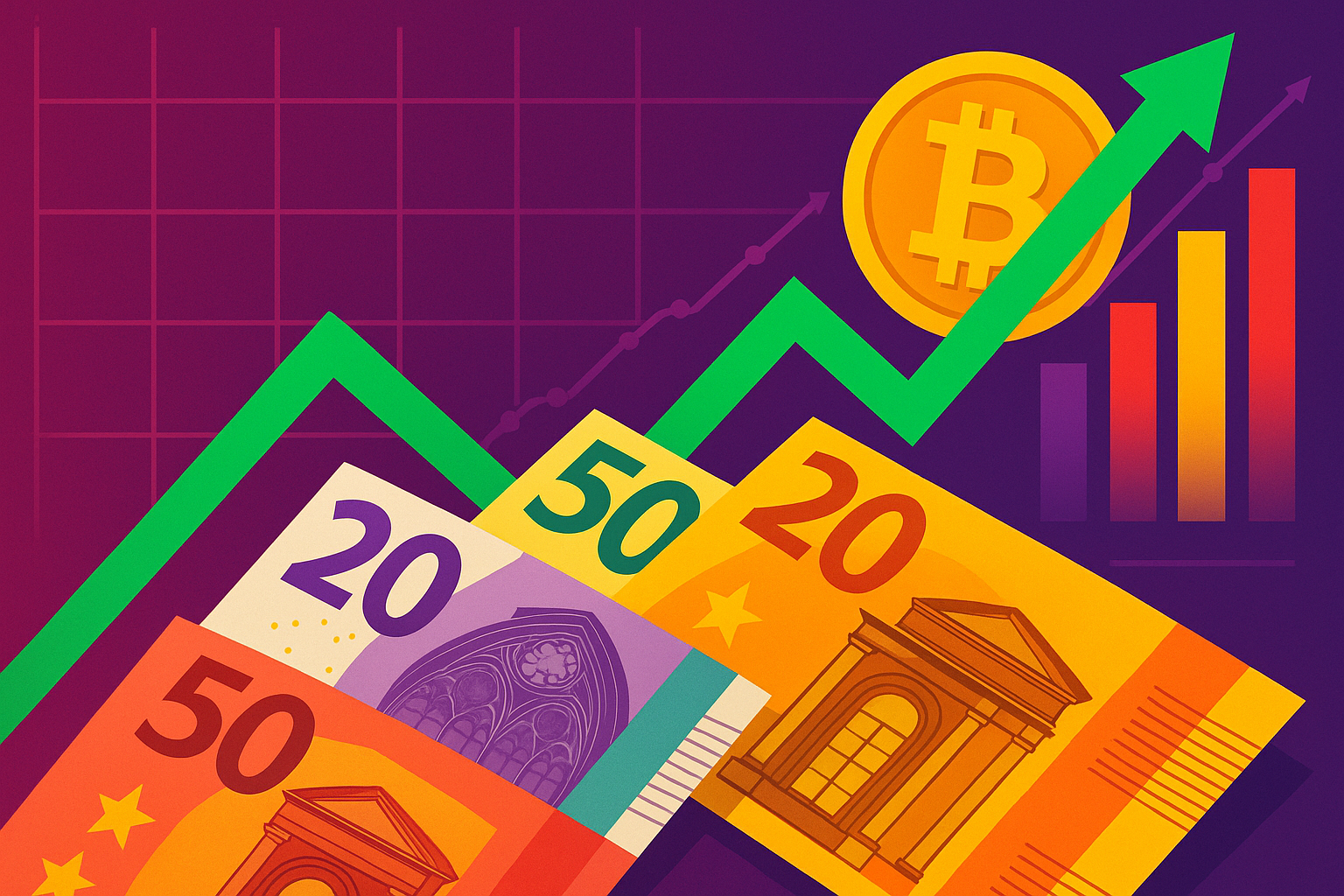Is the OG fiat suddenly the new digital gold?
I’m scratching my head right along with you. The headline numbers say it all: since early January, the euro has rallied roughly 4.8% against the dollar, while Bitcoin, after an epic first-quarter sprint, is basically treading water—down about 2% over the same span. Traditional-finance commentators are already popping prosecco, claiming the EU’s paper money just outperformed the granddaddy of crypto. But I can’t help asking: are we looking at a real trend or just another dead-cat bounce in shiny fiat clothing?
Here’s what actually happened
The narrative kicking around Bloomberg terminals is pretty straightforward:
- U.S. fiscal paralysis—hello, $34.5 trillion national debt—keeps spooking bond traders.
- The ECB is (supposedly) near the end of its rate-cut cycle, giving the euro a relative yield advantage versus the Fed, which might cut harder and faster later this year.
- Result: capital flows out of the dollar and into EUR safe-haven land.
On paper, that dynamic rebukes the classic ‘short-the-euro, long-the-dollar’ playbook that’s dominated macro desks since 2014. And yes, if you measure performance purely in percentage terms since January, the euro is technically ‘beating’ Bitcoin. But I’ve noticed this comparison feels a bit… forced. We’re pitting a 25-year-old fiat bloc against a 15-year-old censorship-resistant network that’s still digesting its own halving and ETF aftermath. Apples to steak, if you ask me.
Why the numbers might be lying
First, remember volatility math. A 4–5% move in a G10 currency is actually huge; for Bitcoin, it’s Tuesday morning noise. When we normalize for historical volatility (I checked Cryptowatch and TradingView before writing this), BTC’s standard deviation over 30 days is about 3.6%; the euro’s is 0.5%. On a risk-adjusted basis, Bitcoin still crushes it.
Second, penny-wise gains vanish when you price in CPI. Eurozone inflation is hovering around 2.6%—better than the U.S., but not exactly deflationary paradise. The real yield on 10-year German Bunds? Roughly 0.3%. Compare that with Bitcoin’s projected post-halving stock-to-flow of 112, the kind of scarcity goldbugs can only daydream about. So yeah, nominal charts can distract.
Anyway, didn’t we learn this lesson in 2017?
Back then, everyone pointed to the yen’s mini-surge against the dollar and declared Japan the new macro champion. Spoiler: by Q3 the yen rolled over, the carry trade came roaring back, and Bitcoin 10×-ed. I see eerie echoes now: politicians bickering over debt ceilings, bond vigilantes flexing on social media, and hedge-fund Twitter dunking on ‘crypto kids’ for dare holding satoshis. Feels poetic.
The Arthur Hayes filter
If you follow Arthur (and frankly, if you don’t, what are you doing on Crypto X?), he’s been pounding the table:
‘All fiat == poop. Some poop just smells less right now.’Couldn’t phrase it better. The euro may be the freshly perfumed dung in a barn full of fiscal disasters, but it’s still dung. Christine Lagarde can’t print credibility, and the German export machine isn’t exactly humming in a deglobalized world. I think markets are latching onto relative optimism because absolute optimism is in short supply.
Let’s talk liquidity plumbing
One reason BTC stalled lately: the U.S. Treasury is hoovering up bank reserves to refill the TGA, effectively draining dollars from risk assets. Meanwhile, the ECB’s balance sheet reductions are slower, leaving euro liquidity intact. In my experience, this matters far more than CNBC sound bites about ‘rate expectations.’ When the Fed eventually pauses TGA rebuild or even restarts QE Lite, Bitcoin historically rips hard. The euro? Not so much—its gains usually fade as the dollar liquidity tide refills.
What about stablecoins?
This is the bit almost every mainstream piece misses. I pinged a dev friend who tracks Curve volumes: euro-denominated stablecoins (EUR-T, agEUR, EUR-CV) still clock less than 2% of daily stablecoin transfers. The crypto rails remain overwhelmingly dollar-centric. Unless that flips, any lasting euro dominance in digital assets feels unlikely. Liquidity gravitates toward the deepest pools, and right now that’s USDT and USDC pairs.
Potential curveballs that could change my mind
I’ll admit I might be missing something. If the EU actually green-lights MiCA 2.0 with clear tax treatment, and if Circle or Tether launches a fully collateralized, high-yield EUR stablecoin, we could see serious adoption. At that point, pricing BTC in euros may matter more. But we’re not there yet. Watching Brussels draft policy is like streaming a turtle marathon in 144p—painfully slow and blurry.
So, should you dump sats for euros?
Personally, I’m not selling a single cold-storage sats stack for a currency that can be frozen by a central bank press conference. If you’re a trader chasing a 4.8% move, sure, knock yourself out on BitMEX’s EURUSD perpetuals. Just remember the funding rates can flip against you in a heartbeat. Long term, I’d rather HODL the asset with a 21 million cap than gamble on bureaucrats holding the fiscal line.
Why this matters for your portfolio
In my group chats, I keep hearing, ‘Maybe the crypto cycle’s over—look at the euro outperforming!’ That kind of lazy thinking led folks to sell the bottom in 2020. Use this euro spike as a reminder to zoom out. Bitcoin’s 5-year ROI: +2,300%. Euro’s: negative against almost any hard asset you care to chart. Don’t confuse a headline with a thesis.
Bottom line
Everyone’s celebrating the euro winning a sprint, but I’m focused on the marathon. The macro backdrop still screams debasement. Bitcoin might be catching its breath, yet its fundamentals—hashrate ATH, supply shock, institutional inflows via ETFs—haven’t gone anywhere. So yeah, congratulations Europe, you clawed back a few pips. Just don’t expect me to swap my ledger for a leather euro wallet any time soon.



